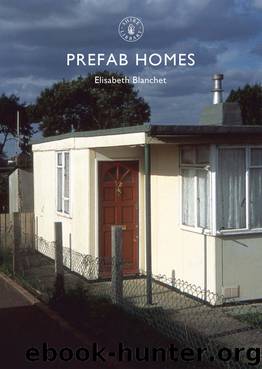Prefab Homes by Elisabeth Blanchet

Author:Elisabeth Blanchet
Language: eng
Format: epub
Tags: Prefab Homes
ISBN: 9781784420284
Publisher: Osprey Publishing
Tarran prefabs in winter, in Killamarsh, North Derbyshire.
Although prefabs had a similar design, came equipped the same way, and were temporary, residents made them their own. Once tenants were allocated their new home, the first thing they had to do was to put up some curtains. Prefabs proved so popular that if one had no curtains, people would think it was available and would harass the housing officers to get it!
Most residents had no money and no possessions because they had been made homeless by the war, or had been living with their in-laws or in furnished rooms. Nevertheless, they still had to purchase items such as beds, a dining table, and chairs, and sometimes had to wait for weeks to get help from the government in the form of essential coupons or ‘dockets’ for utility purchases.
Just after the war, the available choice of goods in department stores was limited. In 1942, the government set up the Utility Furniture Scheme to cope with the shortages of raw materials and to ration consumption. Utility furniture was originally supplied to those who had been bombed out or who were setting up a new home. Sixty coupons were allocated to each eligible person, who decided how to use them. For example, a chair was one docket and a wardrobe was eight. The furniture was solidly constructed, plain, functional, well detailed, and made of oak or mahogany.
Designer Gordon Russell was appointed to the scheme by the Utility Furniture Advisory Committee, and he saw it as a way to show the public the benefits of ‘good’ design. The Board of Trade proposed that the scheme should be ‘influencing popular taste towards good construction in simple, agreeable designs to the benefit of our after-the-war homes’. The standardisation and mass production of the Utility Furniture scheme makes an interesting parallel with the Temporary Housing Programme. Like the prefabs, it provided an opportunity for the government to educate the public towards ‘better taste’.
Rationing of furniture ended in June 1948, but Utility Furniture continued to be produced. However, in January 1953, the Conservative government ended the scheme. Despite the noble intentions of the Utility scheme to show people the virtues of good design, and later in 1946, through the successful Britain Can Make It exhibition, people managed with whatever they could get. Valerie Sommerville, who lived in a prefab in Catford for ten years, recalls: ‘I can remember our first carpet – my grandmother bought army surplus grey blankets and she machined them all together in a quilted pattern and put green bindings on the edges, and we only ever had these carpets in the bedrooms.’
Download
This site does not store any files on its server. We only index and link to content provided by other sites. Please contact the content providers to delete copyright contents if any and email us, we'll remove relevant links or contents immediately.
Aircraft Design of WWII: A Sketchbook by Lockheed Aircraft Corporation(32181)
The Great Music City by Andrea Baker(31230)
Call Me by Your Name by André Aciman(20340)
The Secret History by Donna Tartt(18792)
The Art of Boudoir Photography: How to Create Stunning Photographs of Women by Christa Meola(18493)
Shoot Sexy by Ryan Armbrust(17630)
Plagued by Fire by Paul Hendrickson(17310)
Portrait Mastery in Black & White: Learn the Signature Style of a Legendary Photographer by Tim Kelly(16927)
Adobe Camera Raw For Digital Photographers Only by Rob Sheppard(16878)
Photographically Speaking: A Deeper Look at Creating Stronger Images (Eva Spring's Library) by David duChemin(16580)
Ready Player One by Cline Ernest(14475)
Pimp by Iceberg Slim(14273)
Bombshells: Glamour Girls of a Lifetime by Sullivan Steve(13942)
The Goal (Off-Campus #4) by Elle Kennedy(13415)
Art Nude Photography Explained: How to Photograph and Understand Great Art Nude Images by Simon Walden(12933)
Kathy Andrews Collection by Kathy Andrews(11703)
The Priory of the Orange Tree by Samantha Shannon(8823)
The remains of the day by Kazuo Ishiguro(8778)
Thirteen Reasons Why by Jay Asher(8761)
